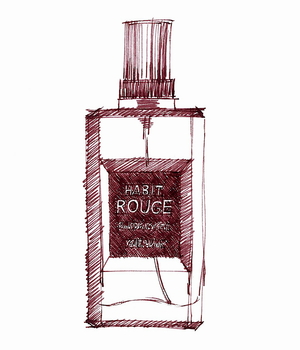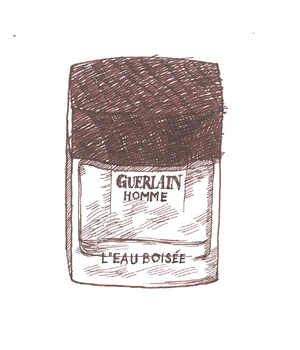Tagged With ‘Habit Rouge’
Guerlain
Habit Rouge
27 April, 2015
 ‘Mass luxury’ may be the oxymoron of the moment, but the name of Habit Rouge is a nod back to a time when perfume really was a luxury enjoyed only by the stinking rich (eg the family Guerlain), among whom fox-hunting was a favourite pursuit.
‘Mass luxury’ may be the oxymoron of the moment, but the name of Habit Rouge is a nod back to a time when perfume really was a luxury enjoyed only by the stinking rich (eg the family Guerlain), among whom fox-hunting was a favourite pursuit.
Habit Rouge, in this context, is the French term for what British toffs call (with typical bourgeois-baiting mystification) ‘hunting pinks’, the scarlet riding jackets worn while hunting the fox. But that’s as far as the hunting or riding references go, which is probably a good thing, if you know what an actual fox or a horse-stable smells like.
Created by the last of the great Guerlain family perfumers, Jean-Paul, and launched in 1965, Habit Rouge was only the third Guerlain fragrance to be aimed at men. In character it is very different from its immediate predecessor, Vetiver, launched in 1959. While Vetiver is elegantly earthy (a brilliant contradiction in terms) and ineffably masculine, Habit Rouge is much more dandified, with a sharp, powdery sweetness that some people love but that makes others gag – imagine lemon sherbert in liquid form and you won’t be far wrong.
According to my friend the perfumer Roja Dove (who worked at Guerlain for twenty years), it ‘has an extraordinary volume of hesperidic materials, especially bergamot and lemon, which make up in excess of 25 per cent of the formula. Without question you can “feel” their effervescence.’It’s so zingy to start with that I wonder whether it might even contain a touch of aldehydes – the chemicals that give Chanel No. 5 its champagne fizz.
With all that lemon you’d imagine it would smell like an eau de cologne, but like other classic Guerlain perfumes Habit Rouge has great depth and complexity, and in the terminology of the perfume world it actually counts as an ‘oriental’-style fragrance, as behind the sherbert there’s a surprising amount of spice as well.
Though the version we have today was apparently ‘cleaned up’, as the industry jargon has it, by another fine perfumer, Edouard Fléchier, to comply with updated regulations governing the use of potentially harmful ingredients, it still smells wonderfully rich, with traces of vanilla and patchouli for those who smell it carefully.
Habit Rouge also lasts and lasts, which for me is an added plus when a perfume is as great as this – for anyone on a limited budget it’s hard to justify spending £70 or so on something that vanishes within an hour of putting it on. Definitely worth hunting down.
Guerlain
Guerlain Homme l’eau Boisée
18 January, 2014
 Few perfume companies have such a great heritage (and so many perfumes) as Guerlain, which is presumably why the luxury behemoth LVMH bought it in 1994. Founded in Paris in 1828 by Pierre-François Guerlain, it reached its apotheosis in the late nineteenth and early twentieth century under Pierre-François’ grandson Aimé (who concocted the wonderful Jicky in 1898) and Aimé’s nephew, Jacques Guerlain.
Few perfume companies have such a great heritage (and so many perfumes) as Guerlain, which is presumably why the luxury behemoth LVMH bought it in 1994. Founded in Paris in 1828 by Pierre-François Guerlain, it reached its apotheosis in the late nineteenth and early twentieth century under Pierre-François’ grandson Aimé (who concocted the wonderful Jicky in 1898) and Aimé’s nephew, Jacques Guerlain.
One of the greatest perfumers of all time, Jacques created a whole series of legendary fragrances between 1906 and 1925, whose names are almost as alluring as the scents themselves: Après l’Ondée in 1906, L’Heure Bleue in 1912, Mitsouko in 1919, Shalimar in 1925, and Vol de Nuit in 1933.
Jacques’ grandson, Jean-Paul Guerlain, continued the family tradition, creating many superb fragrances of his own, for women and for men, including three of my own personal favourites – Vétiver (1959), Habit Rouge (1965) and Héritage (1992). But his reign ended sadly: after the Guerlains sold out to LVMH, Jean-Paul became just one of Guerlain’s hired hands, and in 2010 even his post-retirement role as a consultant was terminated after he made a casually racist remark on French television.
I’ll return to some of my own favourite Guerlain perfumes in future reviews, but I’ve recently been given, very generously, a bottle of Guerlain Homme L’eau Boisée, and as I rather like it I thought it would be good to feature something that was only released in 2012.
L’eau Boisée was created by Thierry Wasser, the Swiss-born perfumer who, before he took over from Jean-Paul Guerlain in 2008, worked for the multinational fragrance company Firmenich and was responsible for perfumes as diverse as Dior’s Addict, Diesel’s Fuel for Life and Kylie Minogue’s Darling.
Wasser’s original Guerlain Homme was released, to mixed reviews, the same year that he joined the company in-house. With a nice touch of wit, it’s based on the smell of a mojito, the Cuban cocktail whose ingredients include white rum, spearmint leaves and lime juice, but it’s been generally described as a fairly mass-market men’s fragrance – perfectly wearable, at least, but hardly up there with Habit Rouge or Jicky.
Since then, impelled by perfume retailers’ insatiable (and ultimately self-defeating) demands for novelty, Wasser has so far created three further versions of Guerlain Homme: Intense (2009), L’eau (2010) and L’eau Boisée. This last is a soft, woody fragrance, whose initial fresh scent of lime fades fairly quickly, to be followed by the warm scent of cedar wood and the pleasantly earthy smell of vetiver (Wasser uses a special vetiver from Tamil Nadu in southern India, apparently, rather than the more usual variety from Haiti or Réunion).
I can’t smell rum in L’eau Boisée, but to me it does have a faint but not unpleasant smell of celery, and a faintly sweaty (but again not unpleasant) scent that reminds me of a bottle of Penhaligon’s Hammam Bouquet that I used up years ago – must go and have a sniff to compare.
Would I rush out and buy a bottle? I’m not sure I would, as it’s hardly a groundbreaking scent; but as new perfumes go it’s both pleasant and rather refined, the kind of thing you could safely buy for an uncle or a friend. I’d be interested to know what you think.